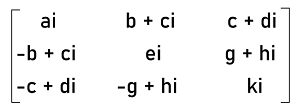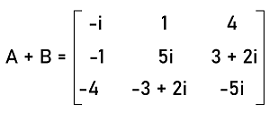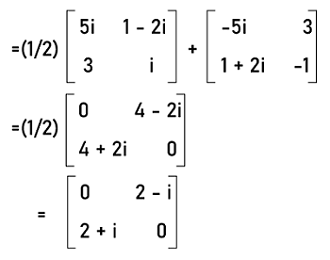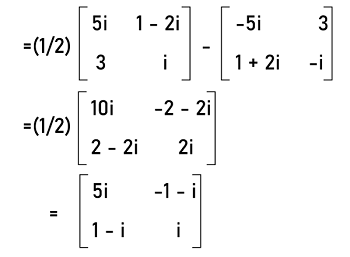Skew-Hermitian matrix in Discrete mathematicsThe skew-symmetric matrix and the skew-Hermitian matrix both have many similarities. In case of the skew-symmetric matrix, the negation of the given matrix and transpose of the matrix are both similar to each other. Similarly, in case of a skew-Hermitian matrix, the negation of the given matrix and the conjugate transpose of the matrix are similar to each other. We can also call the skew-Hermitian matrix as the anti-Hermitian matrix. In this section, we are going to learn about the skew-hermitian matrix, its formula, its properties, its examples, Decomposing matrix into Hermitian and Skew-Hermitian matrices, and many more. What is Skew-Hermitian matrixA matrix will be known as the skew-Hermitian matrix if there is a square matrix in which the negation of the matrix and its conjugate transpose matrix are similar to each other, i.e., AH = -A. Here AH is used to indicate the conjugate transpose of matrix A. It can also be indicated by the symbol A∗. Now we will learn about AH to better understand the concept of a skew-Hermitian matrix. We can get the conjugate transpose of matrix A if we replace every element of the transpose of A (i.e., AT) with its complex conjugate. If there is a complex number x + iy, the complex conjugate of that number will be x - iy. Now we will learn it by an example, which is described as follows: Example: In this example, we have a matrix A, and we have to show how this matrix is a skew-Hermitian matrix. The elements of matrix A are described as follows: 
Solution: The transpose of matrix A is described as follows: 
Now we will do the conjugate transpose of matrix A in the following way: 
Now we will do the negation of matrix A in the following way: 
From equation 1 and equation 2, we can see that AH = -A Hence matrix A is a skew-Hermitian matrix. Suppose A is a skew-Hermitian matrix, and A and AH are used to contain the elements xij and x̅ij, respectively. If these elements are present at the position ith row and jth column, in this case, xij = -x̅ji. This statement shows that a square matrix A will be a skew-hermitian matrix if and only if it contains the following conditions: AH = -A OR xij = -x̅ji 
Formula of skew-Hermitian matrixThere are some interesting facts related to the skew-Hermitian matrix with any number of orders. These facts are described as follows:
The diagonal elements of the above example of a skew-Hermitian matrix are purely imaginary (or they will be zero). In the above example, we can also see that a12 = 1+i and a21 = -1+i. On the basis of these things, it is possible to construct the formula of a skew-Hermitian matrix with an order 2∗2. So in the following form, we can show the 2∗2 skew-Hermitian matrix: 
Here x, y, z, and w are used to indicate the real numbers. Similarly, we can also construct the formula of a skew-Hermitian matrix with an order 3∗3. So in the following form, we can show the 3∗3 skew-Hermitian matrix: 
Properties of Skew-Hermitian matrixThere are various properties of a skew hermitian matrix, and some of them are described as follows:
Decomposing matrix into Hermitian and Skew-Hermitian matrixIf there is a square matrix, then we can write this matrix as the addition of a Hermitian matrix X and skew-Hermitian matrix Y. Suppose there is a square matrix A. Then, A = X + Y A = (1/2) (A + AH) + (1/2) (A - AH). Here AH is used to indicate the transpose of conjugate matrix A. Where X = (1/2) (A + AH) and Y = (1/2) (A - AH) It shows that
Hence if there is a square matrix, then we can write this matrix as the addition of a skew-hermitian matrix and hermitian matrix. Important pointsIt is not important that if there is a normal matrix, then it will also be a skew-Hermitian matrix. There are some important points which we should know while learning the concept of a skew-Hermitian matrix. These points are described as follows:
Examples of skew-Hermitian matrixThere are a lot of examples of Skew-Hermitian matrices, and some of them are described as follows: Example 1: In this example, we have a matrix A, and we have to determine whether it is a Skew-Hermitian matrix. The elements of matrix A are described as follows: 
Solution: First, we will compute transpose of the given matrix A in the following way: 
Now we will do the conjugate of the above transpose matrix in the following way: 
Now we will do the negation of given matrix A in the following way: 
From equation 1 and equation 2, we can see that AH = -A So the given matrix is a skew-Hermitian matrix. Answer: Matrix A is a skew-Hermitian matrix. Example 2: In this example, we have two skew-Hermitian matrices, and we have to determine the addition of these two matrices. We have to also prove that this addition's output is also a skew-Hermitian matrix. The elements of these two skew-Hermitian matrices are described as follows: 
Solution: From the question, we have two skew-Hermitian matrices, A and B. The addition of these two matrices is described as follows: 
Now we will compute transpose of this addition in the following way: 
Now we will do the conjugate transpose of the A+B in the following way: 
Now we will do the negation of the A+B in the following way: 
From equation 1 and equation 2, we can see that (A+B)H = - (A+B) Answer: The addition of two skew-Hermitian matrices will be a skew-Hermitian matrix. Example 3: In this example, we have a matrix A, and we have to decompose it in the form of addition of Hermitian matrix and skew-Hermitian matrix. The elements of matrix A are described as follows: 
Solution: From the question, we have a matrix A where 
The complex conjugate of this matrix is described as follows: 
As we have learned that A = X+Y where X is used to show the Hermitian matrix where X = (1/2) (A + AH) Y is used to show the Skew-Hermitian matrix where Y = (1/2) (A - AH) Now we will put the value of A and AH in X and Y one by one. First, we will take X. So X = (1/2) (A + AH) 
Now we will put the value of A and AH in Y. Y = (1/2) (A - AH) 
Answer: 
|
 For Videos Join Our Youtube Channel: Join Now
For Videos Join Our Youtube Channel: Join Now
Feedback
- Send your Feedback to [email protected]
Help Others, Please Share









